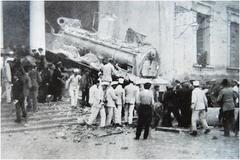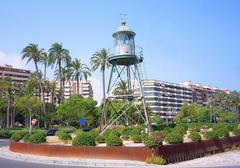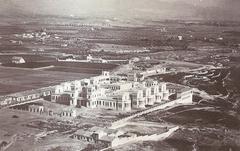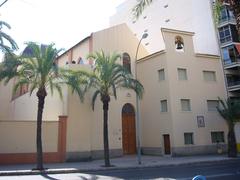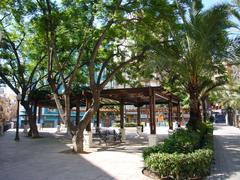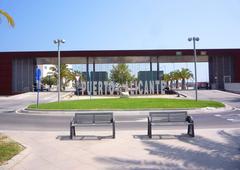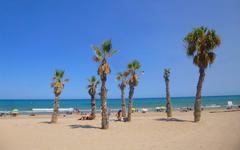
Old Town Santa Cruz Alicante: Visiting Hours, Tickets, and Historical Sites Guide
Date: 04/07/2025
Introduction
Perched on the slopes of Mount Benacantil, the Old Town Santa Cruz in Alicante, Spain, stands as a living testament to centuries of cultural, architectural, and social evolution. This neighborhood, with its unmistakable Moorish roots and deep Christian heritage, welcomes travelers into a vibrant world where history and tradition are woven into daily life (mycostablanca.net; alicantediscovery.com). Whether you are seeking detailed visiting hours, ticket information, guided tours, or practical tips for exploring the charming, steep streets, this comprehensive guide is your essential companion.
Santa Cruz is home to iconic sites like the Castillo de Santa Bárbara, the Concatedral de San Nicolás, and the Basílica de Santa María, and it is renowned for its lively festivals such as Fiesta de las Cruces and Semana Santa (evendo.com; alicanteturismo.com). Beyond the must-see landmarks, you’ll find welcoming plazas, panoramic viewpoints, artisan shops, and a wealth of local culture. This guide blends historical context with actionable insights to make your visit to Alicante’s Old Town truly unforgettable (alicantediscovery.com; ourspanishadventures.com).
Table of Contents
- Moorish Foundations and Medieval Origins
- The Christian Reconquest and Transformation
- Growth, Urbanization, and Social Change
- Top Landmarks and Architectural Highlights
- Visitor Information: Access, Accessibility, and Tours
- Cultural Heritage and Festivities
- Travel Tips and Nearby Attractions
- Santa Cruz’s Role in Alicante’s Identity
- Frequently Asked Questions (FAQ)
- Local Customs and Practical Tips
- Summary and Additional Resources
Moorish Foundations and Medieval Origins
Santa Cruz’s origins date back to the Moorish period (8th–13th centuries), when the area served as a fortified stronghold at the foot of Mount Benacantil. Its urban design—narrow, winding streets, whitewashed houses, and shaded courtyards—reflects classic Islamic city planning, prioritizing privacy, defense, and respite from the Mediterranean sun (mycostablanca.net). Today, the district’s maze of alleyways and intimate plazas still evoke this multicultural past (discoverwalks.com).
The Christian Reconquest and Transformation
The Christian Reconquest in 1248, led by King James I of Aragon, transformed Santa Cruz from a Moorish enclave into a Christian stronghold. New religious buildings—including the Church of Santa Cruz—were constructed, and the area expanded as Christian settlers arrived. The coexistence and blending of Moorish and Christian traditions created the unique cultural tapestry visible in Santa Cruz’s architecture and festivals (evendo.com).
Growth, Urbanization, and Social Change
During the 19th and 20th centuries, Santa Cruz adapted to modern urbanization without losing its historic charm. The introduction of new infrastructure supported a thriving local economy of artisans and small businesses, while the area maintained a vibrant, close-knit community despite economic challenges (mycostablanca.net). Strong local traditions and neighborhood identity persisted, further shaping Santa Cruz’s character.
Top Landmarks and Architectural Highlights
Castillo de Santa Bárbara
- History: Dating to the 9th century, this fortress atop Mount Benacantil offers commanding views of Alicante and the Mediterranean.
- Visiting Hours: April–October: 10:00 AM–8:00 PM; November–March: 10:00 AM–6:00 PM.
- Tickets: Free entry (Splendidly Spain).
- Accessibility: Elevator access from Playa del Postiguet; some steep areas.
Concatedral de San Nicolás
- Architectural Style: 17th-century blend of Baroque and Renaissance with a signature blue dome.
- Visiting Hours: Mon–Sat 10:00 AM–1:00 PM, 5:00 PM–8:00 PM; Sun 10:00 AM–1:00 PM.
- Tickets: Free (donations welcome).
Basílica de Santa María
- Significance: Alicante’s oldest church, built on the site of a former mosque, featuring Gothic and Baroque elements.
- Visiting Hours: Daily 10:00 AM–6:00 PM.
- Tickets: Free (mycostablanca.net).
Calle Labradores
Picturesque street lined with historic buildings, now home to cafés, bars, and artisan shops.
Visitor Information: Access, Accessibility, and Tours
- Getting There: Santa Cruz is centrally located and easily reached on foot from Alicante’s city center. Bus lines 2, 12, and 24 serve the area; Luceros tram station is nearby.
- Accessibility: The medieval, cobblestone streets can be challenging for those with mobility concerns. Main sites like Castillo de Santa Bárbara offer accessible routes.
- Guided Tours: Numerous companies offer historical and cultural walking tours. Book tickets online or at local tourist offices for the best availability.
Cultural Heritage and Festivities
Santa Cruz is celebrated for its vibrant community life and cultural events. Notable festivities include:
- Fiesta de las Cruces: May event where residents decorate crosses with flowers, accompanied by music and communal gatherings (evendo.com).
- Semana Santa: Holy Week processions begin at the Hermitage of Santa Cruz, recognized nationally for their significance (alicanteturismo.com).
- Moors and Christians Festival: Colorful reenactment of historical events with elaborate costumes and parades (alicanteturismo.com; topinfoalicante.com).
- Hogueras de San Juan: Late June festival featuring bonfires, fireworks, and street celebrations (My Costa Blanca).
These events reinforce social bonds and invite visitors to experience local traditions firsthand.
Travel Tips and Nearby Attractions
- Best Times to Visit: Early mornings and late afternoons for pleasant temperatures and photography.
- Nearby Attractions: Explanada de España promenade, Postiguet Beach, Contemporary Art Museum (MACA), and panoramic Mirador de la Santa Cruz.
- Dining: Numerous tapas bars and family-run restaurants offer authentic Spanish and Mediterranean cuisine (Our Spanish Adventures).
- Shopping: Artisan shops selling ceramics, jewelry, and crafts.
Santa Cruz’s Role in Alicante’s Identity
Santa Cruz is the soul of Alicante—a district where every street, plaza, and building reflects centuries of multicultural history. Its enduring traditions, vibrant festivals, and architectural continuity foster a deep sense of belonging for residents and a unique window into Alicante’s heritage for visitors (evendo.com).
Frequently Asked Questions (FAQ)
Q: What are Santa Cruz Alicante’s visiting hours?
A: The neighborhood is open 24/7. Major sites like Castillo de Santa Bárbara: 10:00 AM–8:00 PM (summer), shorter in winter.
Q: Is there an entrance fee?
A: Entry to the neighborhood and most landmarks is free.
Q: Are guided tours available?
A: Yes, with historical, architectural, and cultural themes.
Q: Is Santa Cruz accessible for people with mobility issues?
A: Some areas are challenging due to narrow, cobbled streets; main attractions have accessible routes.
Local Customs and Practical Tips
- Greetings: Use a handshake or two-cheek kiss; “Buenos días” and “Buenas tardes” are appreciated (Rough Guides).
- Dress Code: Modest attire in churches; smart casual in evenings.
- Dining: Lunch 2–4 PM; dinner after 9 PM. Tipping is optional but appreciated (5% or rounding up).
- Payments: Credit cards widely accepted; carry cash for small purchases.
- Safety: Santa Cruz is very safe, but standard precautions apply (SacaVoyage).
- Language: Spanish and Valencian are spoken. English is common in tourist areas; basic Spanish phrases are helpful.
- Getting Around: Best explored on foot; wear comfortable shoes.
- Accessibility: Limited in historic areas; inquire about accessible tours.
- Connectivity: Free Wi-Fi is widespread; local SIM/eSIM cards are affordable.
Summary
Santa Cruz Alicante is a captivating blend of Moorish foundations, Christian heritage, and modern vibrancy. With its iconic landmarks, festive community life, and commitment to preserving its unique character, it offers visitors an immersive journey through Alicante’s living history (mycostablanca.net; alicantediscovery.com). Smart planning—leveraging official resources, guided tours, and local etiquette—ensures a rich and respectful experience.
References and Further Reading
- Santa Cruz Alicante Visiting Hours, Tickets & Guide, My Costa Blanca (mycostablanca.net)
- Cultural Significance and Visitor Guide, Alicante Discovery (alicantediscovery.com)
- Must-See Sites and Attractions, Splendidly Spain (splendidlyspain.com)
- Local Customs and Practical Tips, Rough Guides (roughguides.com)
- Fiesta and Cultural Events, Evendo (evendo.com)
- Alicante Tourism Official Site (alicanteturismo.com)
- Additional Travel Advice: Travel Tom Tom, Our Spanish Adventures, A World to Live, Costa Blanca Online 24
For maps, visual guides, and updated event calendars, visit the official Alicante tourism website or download the Audiala app for on-the-go tips and guided tours.

